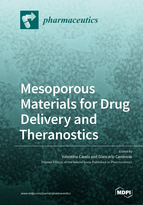Mesoporous Materials for Drug Delivery and Theranostics
A special issue of Pharmaceutics (ISSN 1999-4923). This special issue belongs to the section "Drug Delivery and Controlled Release".
Deadline for manuscript submissions: closed (30 April 2020) | Viewed by 37243
Special Issue Editors
Interests: nanomedicine; nanotechnology; extracellular vesicles; zinc oxide; acoustic cavitation; ultrasound-assisted therapies; drug delivery
Special Issues, Collections and Topics in MDPI journals
Interests: drug delivery system; core–shell structures; nanostructured drug carrier; stimuli-responsive drug delivery; theranostics; micro-nanofluidics; sonodynamic therapy; multifunctional nanoparticles; metal oxides nanostructures; nano-acoustic contrast agents
Special Issue Information
Dear Colleagues,
Mesoporous materials, especially those made of silica, are capturing great interest thanks to their exceptional pore size and surface area and ease surface functionalization, thus enabling a broad series of intervention in the field of nanomedicine. For many years, these aspects have fostered a deep investigation of mesoporous nanoparticles to design and fabricate biocompatible, smart, and even mechanizable nanotools for controlled, stimuli-responsive drug or gene delivery up to the most recent theranostics applications, in particular for cancer therapy.
This Special Issue of Pharmaceutics is dedicated to the most recent advances in the use of mesoporous micro- and nanostructures for designing novel “smart” biomedical systems applied to drug delivery and theranostics. Participation with research papers, short communications, and reviews focused on these topics and describing the synthesis and characterization of mesoporous materials, also in a core–shell configuration with other nanomaterials and their functionalization with smart and stimuli-responsive gatekeepers, as well as reporter molecules or particles for diagnostic applications and their final in vitro and in vivo applications in the nanomedicine field, is highly encouraged.
Prof. Valentina Cauda
Dr. Giancarlo Canavese
Guest Editors
Manuscript Submission Information
Manuscripts should be submitted online at www.mdpi.com by registering and logging in to this website. Once you are registered, click here to go to the submission form. Manuscripts can be submitted until the deadline. All submissions that pass pre-check are peer-reviewed. Accepted papers will be published continuously in the journal (as soon as accepted) and will be listed together on the special issue website. Research articles, review articles as well as short communications are invited. For planned papers, a title and short abstract (about 100 words) can be sent to the Editorial Office for announcement on this website.
Submitted manuscripts should not have been published previously, nor be under consideration for publication elsewhere (except conference proceedings papers). All manuscripts are thoroughly refereed through a single-blind peer-review process. A guide for authors and other relevant information for submission of manuscripts is available on the Instructions for Authors page. Pharmaceutics is an international peer-reviewed open access monthly journal published by MDPI.
Please visit the Instructions for Authors page before submitting a manuscript. The Article Processing Charge (APC) for publication in this open access journal is 2900 CHF (Swiss Francs). Submitted papers should be well formatted and use good English. Authors may use MDPI's English editing service prior to publication or during author revisions.
Keywords
- high porosity
- colloidal dispersion
- host–guest interaction
- core–shell structures
- surface functionalization
- pore gatekeepers
- stimuli-responsive drug delivery
- cell targeting
- gene therapy







